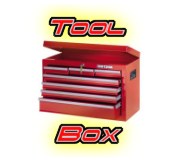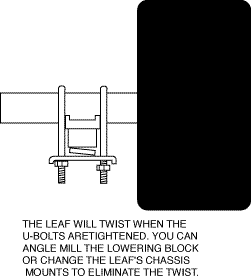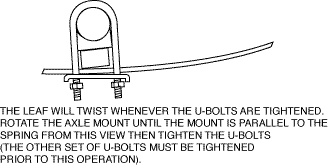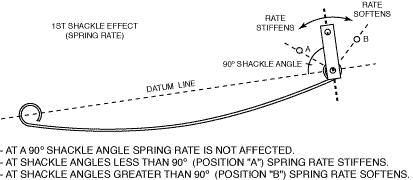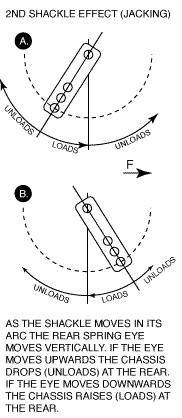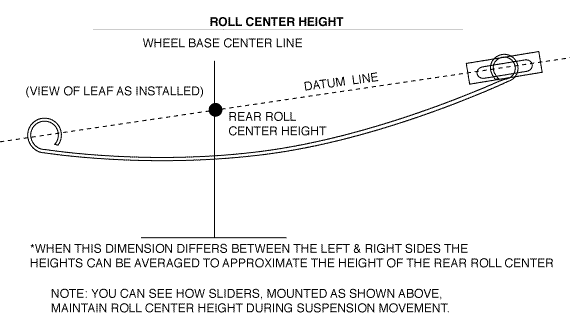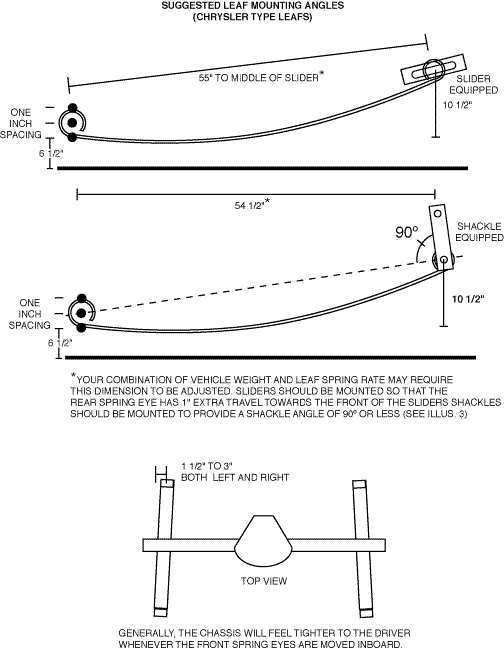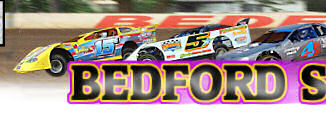 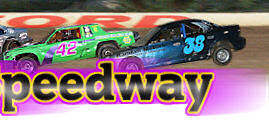 |


LEAF SPRING TECHNOLOGY
|
For instance, the axle mount deadens part of the leaf and an increase in spring rate results. The increase is proportional to the amount of spring that is deadened by the mount. You can expect an increase in spring rate after replacing "factory type" rubber lined axle mounts (which deaden relatively little of the leaf) with solid axle mounts and lower plates. Any lengthwise twisting of a leaf spring will also cause an increase in spring rate. The increase is proportional to the degree of the twist. The twist results from stagger, wedge, bent axle tubes, misaligned chassis mounts, etc. that cause the axle mount and spring to be at an angle to each other from a rear view.( see illus. 1) The leaf twists whenever it is tightened flat to the unparallel axle mount.
Leaf twist is more pronounced with solid type leaf eye bushings than with the more pliable rubber bushings. Practically all potential for twisting a leaf spring is eliminated by using an AFCO front eye pivot instead of a bushing. Your leaf will become softer as twist in the leaf is reduced. At the least, you should eliminate any static twist present in your leaf springs whenever your chassis is at ride height. Otherwise, you may unknowingly change rear spring rate whenever you replace or adjust rear suspension components. A static tension in the leafs is present whenever the leafs and axle mounts are not parallel from a side view(see illus. 2). Any static tension will cause an increase in spring rate. You can check for this tension by placing jack stands under both leaf springs directly below the axle and then unbolting one side of the axle from its leaf (use this same procedure on both leafs to check for lengthwise twist). The axle mount should seat evenly to the leaf as viewed from the side. If necessary, reposition the axle clamp on the axle tube to eliminate any twist. AFCO clamp-on axle brackets will facilitate corrections.
SHACKLES
A good starting point for shackle angle is 90 degrees. In this position the shackle has no effect on spring rate. Keep in mind that the shackle angle changes (and consequently the spring's effective rate changes) whenever the suspension moves. Also, the shackle's angle will change whenever you change the chassis' ride height, the arch of the leaf, the load on the leaf, or the length of the shackle. Since the shackle direction changes when the leaf is deflected past a flat condition, you should avoid deflecting the right rear leaf to an extremely negative arch condition. This could cause a very large shackle angle at high loads and consequently a very soft spring rate. Excessive body roll and poor handling could result. You can correct this problem by decreasing the shackle angle, increasing the arch, of the spring by increasing the rate of the right rear leaf spring. Shackle length is another factor affecting the rate of a leaf spring. A short shackle will change its angle (and the effective rate of the leaf spring) quicker than a long shackle upon deflection of the leaf. There is a second shackle effect on the stiffness of the rear suspension that counteracts and sometimes exceeds the shackleºs effect on spring rate. This second effect occurs whenever the shackle swings in its arc and moves the rear spring eye vertically.(see illus. 4)
The vertical movement of the rear spring eye causes a jacking effect. If the shackle movement forces the rear spring eye downward, the leaf will deflect and exert an upward force on the chassis that will add stiffness to the rear suspension. Conversely, the shackle will reduce suspension stiffness if t causes the rear spring eye to move upward during suspension travel. The stiffening effect occurs during suspension deflection whenever the rear spring eye is ahead of the upper shackle pivot and the shackle is moving rearward (see illus. 4, example B). In this position, however, the shackle also produces a softening effect by reducing the effective rate of the leaf spring (due to the large shackle angle). The overall effect to the stiffness of the rear suspension is determined by the greater of the two shackle effects. Under opposite conditions, you can expect a reversal to the above effects. If the rear spring eye is located behind the shackle pivot (illus. 4 example A) the shackle effect will tend to reduce suspension stiffness whenever the shackle moves rearward. However, the small shackle angle will tend to stiffen the spring's rate. The overall effect to the suspension's stiffness is determined by the more dominant of the two shackle effects. Keep in mind that the movement of the rear spring eye (from its static position) is mostly forward under racing conditions. If a leaf goes into negative arch the travel direction of the shackle changes and the shackle effects change. Handling is not consistent under these conditions. The second effect of the shackle can be enhanced by increasing the length of the shackle. Generally, the second shackle effect (jacking)is dominant. SLIDERS ROLL CENTER HEIGHT
A. More Arch: change in spring rate“see shackle section)
1. More "tight" roll steer (may tighten
handling) 2. Increased rear suspension stiffness 3. Lowered roll
center(increases body roll and rear side bite-handling tightens)
4. Less body/tire separation during acceleration and deceleration
(may tighten initial corner entry handling and may reduce initial
forward bite) LOWERING BLOCKS Too much lowering block* can cause the forward thrust of the rear axle to prevent the leafs (or torque arm) from wrapping up and absorbing engine torque. Consequently, forward bite is diminished. A symptom of this problem shows up on torque arm equipped cars as very little 5th coil/shock movement. *The distance between the bottom of the axle tube and the top of the leaf should not exceed 4 1/2". What to look for in a quality leaf spring: 1. Smooth, continuous and consistent arch 2. No lengthwise twist 3. High strength steel 4. Heat treated 5. Tension side of leaf shot-peened for increased durability (produces a satin smooth finish) 6. Rubbing blocks between secondary leafs 7. Secondary leafs taper cut at ends. 8. Proper eye alignment (front and rear eyes should be parallel in all directions).
Remember, the many factors of a leaf spring suspension
are interrelated and a change to one aspect of the suspension usually
affects others. Consequently, the handling results are not always
as predicted! Hopefully this text will provide you with the understanding
necessary to correctly analyze handling and adjust your leaf spring
suspension correctly. |
All photos are property of the credited photographer

